This step by step diy woodworking project is about a 12×12 wooden modern pavilion plans. This is a unique project as it features a modern design with simple lines and no accolades. Thus, my design has two advantages: it keeps the costs down since it’s easy to build, and it can match the architectural style of any backyard. Make sure you take a look over the local building codes, so you comply with the regulations. Take a look over the rest of our woodworking plans, if you want to get more building inspiration. Check out the Shop, as well, for full list of Premium Plans.
When buying the lumber, you should select the planks with great care, making sure they are straight and without any visible flaws (cracks, knots, twists, decay). Investing in cedar or other weather resistant lumber is a good idea, as it will pay off on the long run. Use a spirit level to plumb and align the components, before inserting the galvanized screws, otherwise the project won’t have a symmetrical look. If you have all the materials and tools required for the project, you could get the job done in about a day. See all my Premium Plans HERE.
Pin for Later!

Projects made from these plans
12×12 Modern Lean to Pavilion Plans
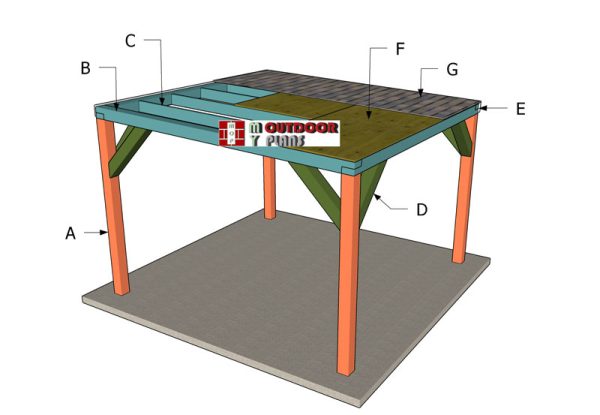
Building-a-12×12-modern-pavilion
Cut + Shopping Lists
A – Posts – 6×6 lumber 8′ long – 2 pieces
A – Posts – 6×6 lumber 90″ long – 2 pieces
B – Top frame – 6×6 lumber 12′ long – 4 pieces
C – Rafters – 2×6 lumber 133 1/8″ long – 5 pieces
D – Braces – 6×6 lumber 33 7/8″ long – 2 pieces
D – Braces – 6×6 lumber 35 3/8″ long – 2 pieces
D – Braces – 6×6 lumber 42 3/8″ long – 2 pieces
D – Braces – 6×6 lumber 40 3/8″ long – 2 pieces
E – Trims – 1×6 lumber 12′ long – 2 pieces
E – Trims – 1×6 lumber 145 5/8″ long – 2 pieces
F – Roof Sheets – 3/4″ plywood 4’x8′ – 3 pieces
F – Roof Sheets – 3/4″ plywood 4’x4′ – 3 pieces
Tools
![]() Hammer, Tape measure, Framing square, Level
Hammer, Tape measure, Framing square, Level
![]() Miter saw, Drill machinery, Screwdriver, Sander
Miter saw, Drill machinery, Screwdriver, Sander
Time
It’s that easy to build a pavilion!
How to build a 12×12 pavilion – laying out
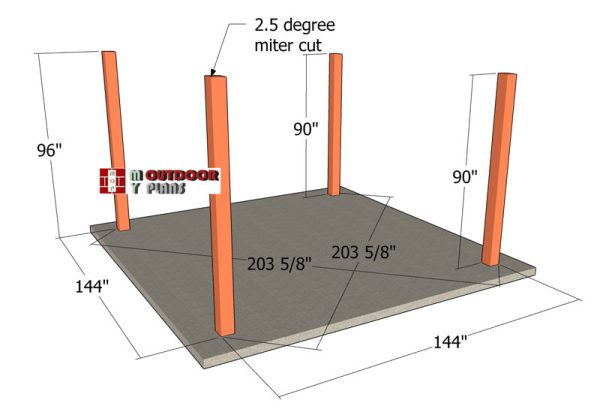
Laying-out-the-posts
First, layout the posts for the 12×12 modern pavilion. Use batter boards and string to determine the location of the posts. Apply the 3-4-5 rule to every corner of the pavilion, so you make sure they are right angled. Make sure the diagonals are equal and make adjustments if necessarily.
Determining the location for the pavilion is essential, as you have to comply with the local building codes. Make sure the surface is level and remove the vegetation layer. Notice the 2.5 degree cuts to the top of the posts. This will create the lean to for the pavilion.
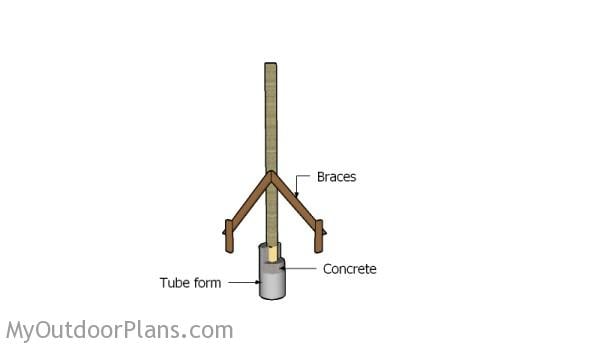
Setting the posts in concrete
Dig 3 ft holes into the ground, making sure they have about 12″ in diameter. Fit the tubes then the posts into the ground and plumb them with a spirit level. Use temporarily braces to make sure the posts are locked into placed while filling the holes with concrete. Let the concrete dry out for several days. Read the local codes for more details on how to secure the posts.
Use lag screws to secure the posts to the anchors. Before pouring the concrete you need to make sure the top of the posts are horizontal one to another. Use a laser to mark the level to the top of the posts and use a circular saw, if you need to make cuts.
Building the frame of the large pavilion
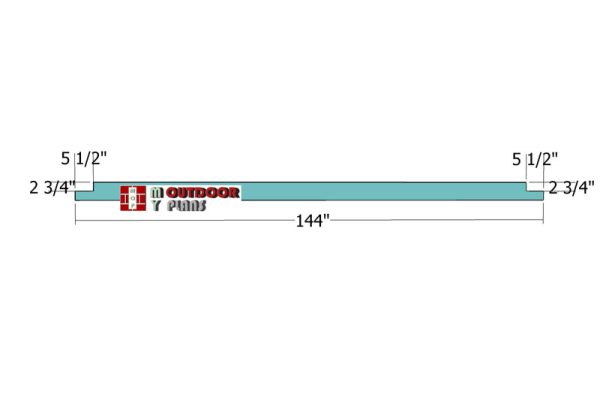
Top-support-beams
Use 6×6 lumber for the top rails. Mark the cut lines on the beams and then make the cut outs with a circular saw and a chisel. Smooth the surface with sandpaper. Set the circular saw at 2 3/4″ and then make parallel cuts inside the marked areas. Clean the recess with a chisel, a hammer and sandpaper.
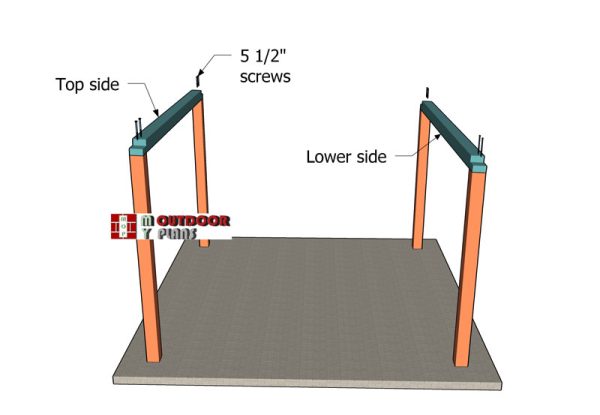
Fitting-the-top-plates
Fit the top rails to the front and back of the gazebo. Drill pilot holes through the plates and insert 5 1/2″ screws to lock them to the posts. Use 2 screws for each joint. Make sure the corners are square and plumb the posts vertically.
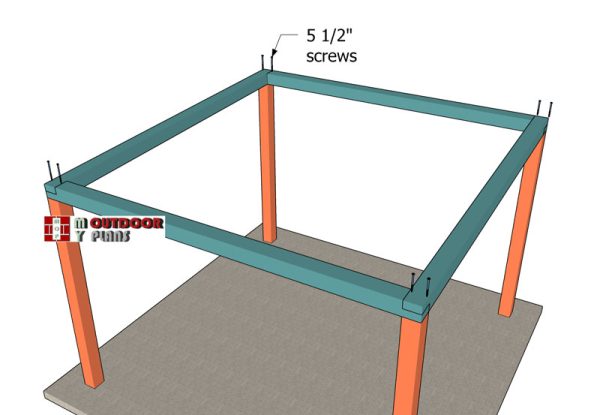
Attaching-the-side-plates
Fit the cross plates to the pavilion. Align the edges flush and drill pilot holes. Insert the 5 1/2″ screws to lock the cross plates into place tightly.

Rafters
Use 2×6 lumber for the rafters. Cut the beams to 133 1/8″/.
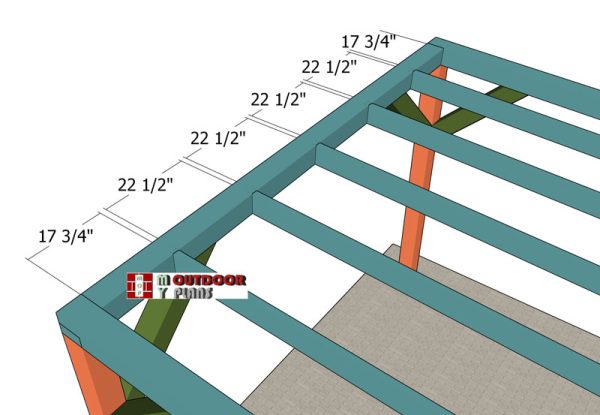
Fitting-the-rafters
Fit the rafters to the roof of the gazebo, every 24″ on center.
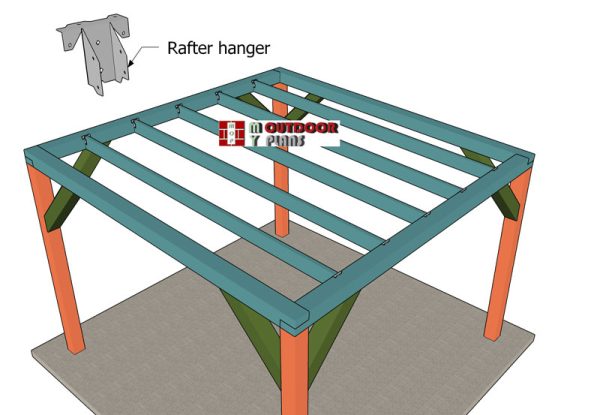
Attaching-the-rafters—detail
Use rafter hangers and 1 1/2″ structural screws to lock the rafters to the frame of the pavilion.
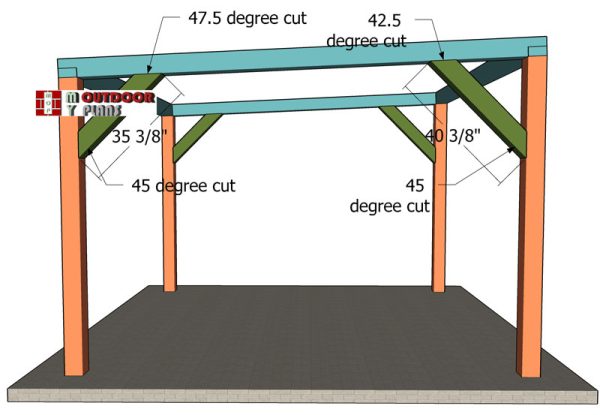
Side-braces
Build the braces for the front and back of the pavilion from 6×6 lumber. Use a miter saw to make angle cuts to both ends of the braces. Fit the braces to the posts, after you plumb them vertically. Drill pilot holes and insert 5 1/2″ screws to secure the braces into place tightly. Insert 2 screws for each joint.

Braces—low-side
Repeat the process for the low side of the gazebo. Notice the angles and follow the instructions to get the job done properly.
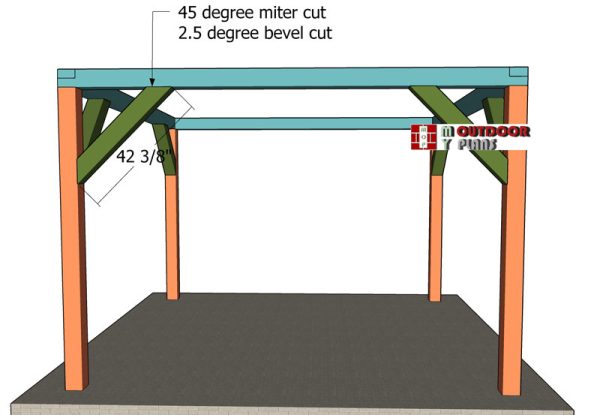
Braces
Cut and fit the braces to the tall side of the pavilion. Use two 5 1/2″ screws to lock the braces into place.
Building the roof of the pavilion
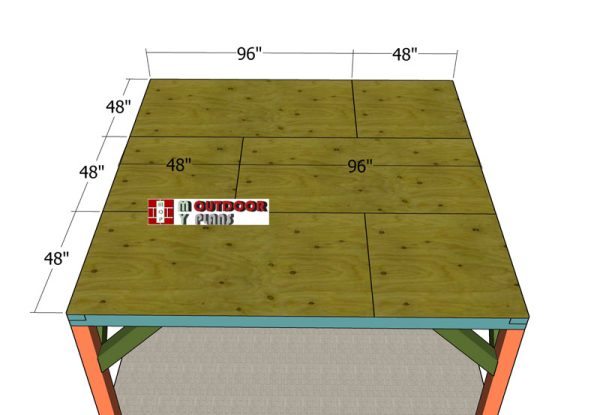
Fitting-the-roof-sheets
Fit the 3/4″ plywood sheets to the roof. Start laying the sheets from bottom left and continue to the top, as shown in the diagram. Leave no gaps between the panels and insert 1 5/8″ or 2 1/2″ screws to lock them to the framing, every 8″. Align the edges flush.
Fitting the roofing
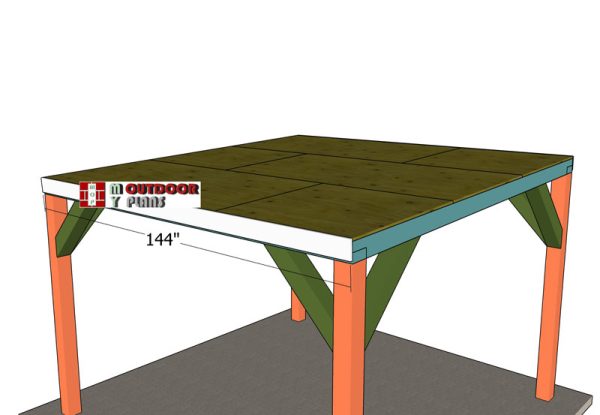
Roof-trims
Attach the 1×6 trims to the front and back of the pavilion. Align the edges with the top edge of the roof sheets. Insert 2″ nails to lock the trims to the frame of the pavilion.

Side-roof-trims
Next, attach the trims to the sides of the pavilion, as well. Align the edges flush and insert 2″ nails to lock them into place tightly.
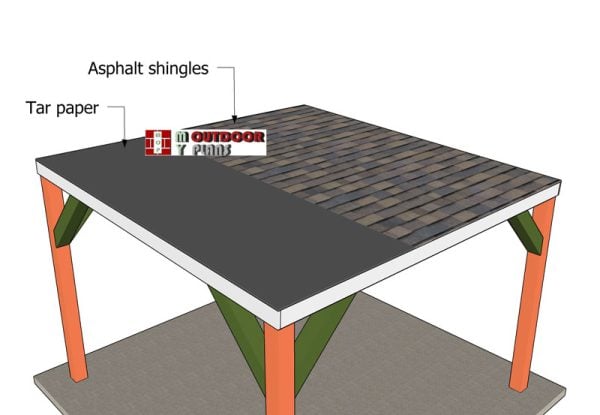
Fitting-the-roofing
To install asphalt shingles to the new lean-to pavilion roof, begin by laying an asphalt underlayment over the plywood sheathing, ensuring complete coverage and proper overlapping. Start at the lower edge with a starter strip, securing it with roofing nails. Lay the first row of shingles along the eaves, aligning the tabs with the starter strip and nailing them down. Continue installing subsequent rows, staggering shingle joints and following the manufacturer’s guidelines for overlap and fastening.
Enhance the aesthetic appeal with a weather-resistant stain or paint to protect the wood and add a polished look. Finally, consider incorporating comfortable outdoor furniture and lighting fixtures to create a welcoming and functional space for relaxation and gatherings.
Finishing touches
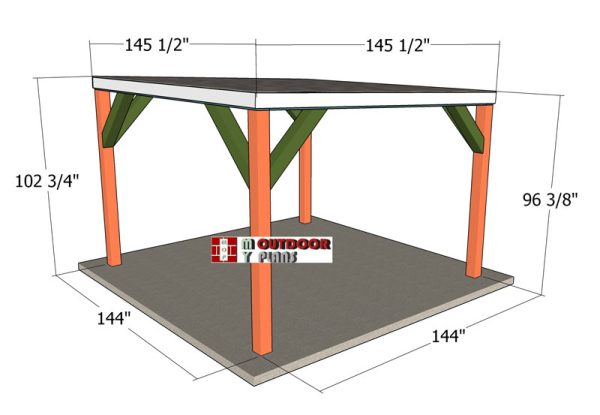
12×12-modern-pavilion—dimensions
See the overall dimensions of this pavilion in the image above.
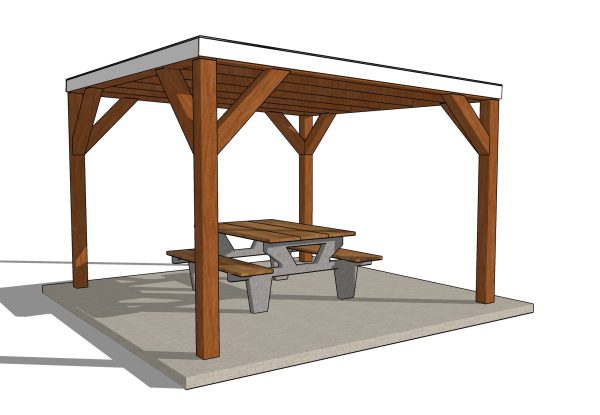
12×12 modern pavilion – back view
Fill the holes with wood putty and let them dry out for a few hours. Smooth the surface with 100-220 grit sandpaper and remove the residues with a damp cloth.

12×12 modern gazebo plans
Top Tip: Apply a few coats of paint or stain to the components, to enhance the look of the project. Check out the Shop, as well, for full list of Premium Plans. Press the GET PDF PLANS button bellow, if you want to get the Premium Plans with the full Cut and Shopping lists included, as well as with the cut layout diagram.
This woodworking project was about 12×12 modern pavilion plans. If you want to see more outdoor plans, check out the rest of our step by step projects and follow the instructions to obtain a professional result.

